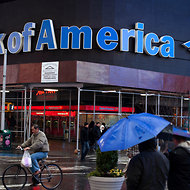 Victor J. Blue/Bloomberg NewsBank of America‘s fourth-quarter gain was overshadowed by continuing weakness on Wall Street.
Victor J. Blue/Bloomberg NewsBank of America‘s fourth-quarter gain was overshadowed by continuing weakness on Wall Street.
8:15 p.m. | Updated
For Bank of America, less is more.
Even as the company reported a $2 billion profit in the fourth quarter on Thursday, what was once the country’s largest bank continued to shrink, wiping tens of billions of dollars from its balance sheet and laying off nearly 7,000 employees.
The results are the clearest evidence so far of the chief executive Brian T. Moynihan’s view that bigger isn’t better, and Wall Street seemed to agree — Bank of America shares rose more than 2 percent to just under $7 a share, the highest level since October. The boost was a rare break for long-suffering Bank of America investors, who watched its shares dive by more than 50 percent last year.
While the profit was a turnaround from the fourth quarter of 2010, when Bank of America lost $1.2 billion, it was largely a result of one-time gains. They included $2.9 billion from the sale of a stake in China Construction Bank and $1.2 billion on the exchange of preferred stock for common stock.
The moves helped the company solidify its underlying capital position in the face of huge losses on soured mortgages. The bank has been submerged in red ink stemming from its 2008 acquisition of the subprime specialist Countrywide Financial. That purchase has saddled the bank with over $30 billion in losses.
“We enter 2012 stronger and more efficient after two years of simplifying and streamlining our company,” Mr. Moynihan said in a statement.
The bank has been under pressure from investors and regulators to strengthen its capital position under international rules and catch up to competitors with higher ratios. The company now expects the Tier 1 capital ratio under new Basel regulations to finish the year at between 7.25 and 7.5 percent, up from a previous target of 6.75 to 7 percent. Regulators argue that a bigger buffer of capital makes banks less reliant on borrowed money and enhances the stability of the financial system.
“The earnings were definitely weaker than we expected but their comments on capital were better,” said Moshe Orenbuch, an analyst with Credit Suisse.
Mr. Orenbuch and other analysts noted that the worry now was how the bank was going to cut expenses and expand profits from the core businesses that remain. The banking industry is being buffeted by new rules that cut into once-lucrative fees charged to consumers as well as new restrictions on how much risk banks can employ on Wall Street.
“There is uncertainty about the long-term earnings power of the company, but they’re pursuing the right strategy,” said Chris Kotowski, an analyst with Oppenheimer.
“Everybody wants to see more capital and you don’t want to stick out from the pack,” he added. “They’ve closed a lot of the gap.” Echoing a trend at Citigroup and JPMorgan, which both recently reported fourth-quarter results, Bank of America’s traditional lending businesses were healthier than capital markets activities like stock and bond trading. Revenue dropped by 31 percent in the company’s global banking and markets unit, which includes Bank of America Merrill Lynch, as the unit recorded a net loss of $433 million.
International lending helped propel faster growth in loans from the global banking and markets division, rising 9 percent to $131 billion. “Loan demand globally is stronger than it is in the U.S.,” said Bank of America’s chief financial officer, Bruce R. Thompson. “And with the pullback of European institutions, we’re going to see more opportunities for loan growth.”
For the quarter, Bank of America earned 15 cents, matching analyst estimates. For the full year, it earned just a penny a share, or $1.4 billion, having taken huge charges against earnings because of the mortgage mess. That was better than the full-year result for 2010, when the bank lost $2.2 billion, or 37 cents a share.
Thursday’s report offered clues to how broad the company’s retrenchment has been. Besides the job cuts, which took Bank of America’s head count to 281,791 at the end of the fourth quarter, the bank closed more branches than it opened in 2011. More jobs are expected to disappear as the company’s restructuring eventually reduces its work force by roughly 30,000.
In what was seen as a sign of consumer displeasure with the $5 debit card fee that the bank decided to impose last summer before dropping it in the fall, total deposits shrank in the fourth quarter by just over $5 billion, to $417.1 billion. “We had some impact from the $5 debit card fee. That’s why we decided to reverse it,” Mr. Moynihan said in a conference call with analysts.
Article source: http://dealbook.nytimes.com/2012/01/19/bank-of-america-swings-to-a-profit/?partner=rss&emc=rss
Speak Your Mind
You must be logged in to post a comment.